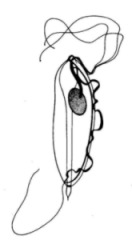
The
origin of bovine trichomonosis
Bovine trichomonosis is a serious disease caused by the flagellate Tritrichomonas foetus. The clinical symptoms of the disease in cows vary from mild vaginitis to acute inflammation of reproductive tract. The disease is usualy asymptomatical in bulls. During pregnancy the disease results in early embryonic death, abortion and sporadically in pyometra leading in some cases to permanent infertility. The infection with Tritrichomonas foetus decreases the fertility of herds and has considerable economical consequences. A striking similarity of the species Tritrichomonas foetus and Tritrichomonas suis, a harmless comensal of intestine and nasal cavity of pig, was widely discussed since the description of Tritrichomonas foetus. The sequences of ITS1, 5,8S rRNA, ITS2 (450 bp) and partial sequences of 16 rRNA (501 bp) showed 100% identity between these two species. Two independent RAPD analyses done by Felleisen and by us also support the idea that T. foetus and T.suis strains belong to the same species. These findings open a new question whether the pig or the cow is the original host of this parasite. It is thought that pig is a more likely candidate for the original host species, because of more typical localisation and harmlessness of the infection in this host. However, no serious work was done in this field. We decided to trace the history of this infection using molecular methods. We suppose that population of the parasite is more polymorphic in the original host than in the secondary one, because only small part of original polymorphism is usually transferred during the infection of the secondary host (due to bottleneck effect) and also because in the primary host species the population of the parasite had more time to diversify. Our results from RAPD analysis didn't show much difference in variability of trichomonads in pig and cattle. However, this can by caused by small number of isolates included in the analysis. We plan to make wider-range analysis not only with more isolates from domestic pig and cattle but also with isolates from wild pig and wild living bovine species.